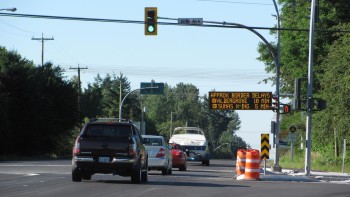 There’s a growing trend in the transportation industry as it shifts toward using more intelligent transportation systems (ITS) — the advanced technology applications used to provide innovative services for transportation and traffic management.
There’s a growing trend in the transportation industry as it shifts toward using more intelligent transportation systems (ITS) — the advanced technology applications used to provide innovative services for transportation and traffic management.
Across the country, construction companies and transportation agencies are using ITS to provide motorists and workers alike with safer, more efficient work zones by using technology that delivers real-time traveler information, more in-depth traffic monitoring and more holistic work zone planning.
But even beyond providing safer, more reliable roadways, these technologies streamline construction processes and act as preventative measures to detect potential issues that couldn’t otherwise be captured.
These technologies allow us to identify a variety of factors within a work zone that could have potentially dire effects on motorists and construction workers. By collecting data on known work zone issues in real time, we’re able to make adjustments that mitigate these problems on the fly and can look to the future, implementing solutions that will avoid these problems down the road.
Safer Travel for Motorists
The biggest benefit of using ITS in work zones is the improved mobility and overall safety for all road users. And for motorists, that means having access to real-time travel information that allows them to make better-informed decisions as they navigate through work zones.
By using ITS technologies, like dynamic message signs motorists are immediately updated on traffic flow, like potential backups that might cause a sudden decrease in speed, or suggestions for alternate routes due to construction closures. Drivers also can know which lanes are closed ahead, allowing traffic to start moving away from construction vehicles on the side of the road.
Automated traffic management — including dynamic signs or radar detection devices that provide accurate and reliable travel times — creates better-informed motorists who benefit from a decreased risk of accidents, less frustration traveling through the work zone and fewer — or shorter — travel delays.
Variable speed messaging, dynamic lane control signage or dynamic messaging for poor weather conditions — like ICY BRIDGE AHEAD when temperatures drop — are also examples of how ITS technologies can enhance motorist safety in a permanent or temporary basis such as a work zone.
Intelligent systems like these have already had a great effect on motorist safety through their ability to decrease the risk of accidents, lessen the consequences of crashes and reducing the exposure to crash risk.
Protecting Road Construction Workers
When work zone construction disrupts the normal flow of traffic, road construction and utility workers face serious risk of injury, and even death, when drivers are unprepared to respond to work zone conditions. But tapping into the benefits of ITS, technologies can provide road workers with a safer, more predictable construction site.
Just like the benefits to motorists, dynamic speed limit signs allow for greater flexibility when regulating speeds in and around a work zone. By using radar detection, these signs are able to collect data about upstream traffic near a construction zone. This information allows the construction manager and owner to work together to identify the appropriate speed for that particular work zone, a speed that balances safety measures and vehicle throughput.
These dynamic speed limit signs also provide flexibility when workers need to construct near open lanes of traffic and don’t have the protection of a guardrail — or, if a lane needs to be closed, the site manager can quickly and easily reduce the work zone’s posted speed limit.
And intrusion warning devices — another form of dynamic messaging — provide effective warning indications to both errant drivers and road workers. If a motorist enters a lane with work crews, an ITS device immediately pushes a display message to a dynamic sign alerting the driver to the crews ahead. The movement also triggers an auditory alarm through the on-body pagers worn by workers.
By giving adequate warning time to both the driver and worker, both parties can prevent potential accidents. This preventative system dramatically improves the project’s construction process and quality by allowing those workers to focus on the task at hand rather than watching vehicles go through the work zone.
Answering the Nation’s Infrastructure Question
With the increased focus on rebuilding highway infrastructure and improving existing roadways, we as an industry need to be prepared to handle and navigate these changes from a safety and constructability standpoint.
With the congestion and safety issues that are often associated with work zones, transportation agencies are presented with the unique challenge of needing to execute these maintenance projects while safely mitigating the unpredictable, unstable traffic caused by construction.
A solution? Utilizing intelligent transportation systems to help improve mobility and safety by holistically and actively managing work zone traffic. In the end, smart technologies, like ITS, breed smart infrastructure.
At Burns & McDonnell, our long reputation for using innovative ideas for revolutionary projects is evident in how we develop ITS solutions for work zones. Safety is the foundation of everything we do at Burns & McDonnell.
Not only do we trust these technologies for our clients’ projects, we trust them for the projects where own employee-owners work.
Want to learn more? Connect with me on LinkedIn or comment here and let’s chat about how ITS can help improve work zone safety.
Andrew Reid, PE, PTOE, is a transportation project manager at Burns & McDonnell, specializing in intelligent transportation systems. He has served as project manager on a variety of transportation-related projects.
photo credit: Look Up and Wait Less via photopin (license)
